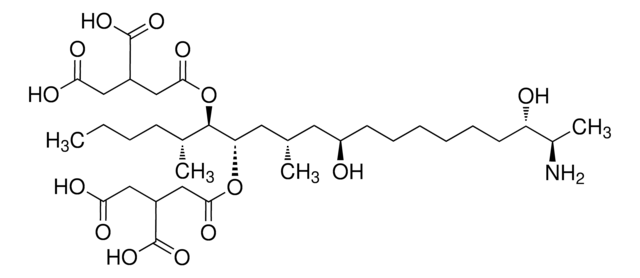32927
3-Acetyldeoxynivalenol
Synonym(s):
3α-Acetoxy-7α,15-dihydroxy-12,13-epoxytrichothec-9-en-8-one, 3α-Acetylvomitoxin, 3-AcDON
Select a Size
Select a Size
About This Item
Recommended Products
grade
analytical standard
reference material
Quality Level
shelf life
limited shelf life, expiry date on the label
manufacturer/tradename
Manufactured by: Sigma-Aldrich Production GmbH, Switzerland
technique(s)
HPLC: suitable
gas chromatography (GC): suitable
application(s)
cleaning products
cosmetics
food and beverages
personal care
format
neat
storage temp.
−20°C
SMILES string
[H][C@]12O[C@]3([H])[C@@H](C[C@@](C)([C@]34CO4)[C@@]1(CO)[C@H](O)C(=O)C(C)=C2)OC(C)=O
InChI
1S/C17H22O7/c1-8-4-11-16(6-18,13(21)12(8)20)15(3)5-10(23-9(2)19)14(24-11)17(15)7-22-17/h4,10-11,13-14,18,21H,5-7H2,1-3H3/t10-,11-,13-,14-,15-,16-,17+/m1/s1
Looking for similar products? Visit Product Comparison Guide
General description
Application
- Cereals by gas chromatography-mass spectrometry (GC-MS).
- Milk samples by liquid chromatography combined with tandem mass spectrometry (LC-MS/MS).
related product
signalword
Danger
hcodes
Hazard Classifications
Acute Tox. 2 Oral - Acute Tox. 3 Dermal - Acute Tox. 3 Inhalation
Storage Class
6.1A - Combustible acute toxic Cat. 1 and 2 / very toxic hazardous materials
wgk_germany
WGK 3
flash_point_f
Not applicable
flash_point_c
Not applicable
ppe
Eyeshields, Faceshields, Gloves, type P2 (EN 143) respirator cartridges
Choose from one of the most recent versions:
Already Own This Product?
Find documentation for the products that you have recently purchased in the Document Library.
Customers Also Viewed
Our team of scientists has experience in all areas of research including Life Science, Material Science, Chemical Synthesis, Chromatography, Analytical and many others.
Contact Technical Service






